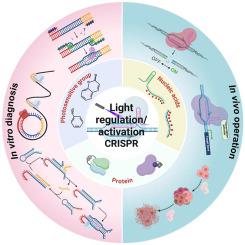Photoactivation/regulation of CRISPR systems: From in vitro diagnosis to in vivo gene manipulation
IF 12
1区 化学
Q1 CHEMISTRY, ANALYTICAL
引用次数: 0
Abstract
CRISPR technology has extensive applications in the biomedical field, whether in in vitro molecular diagnosis or in vivo gene manipulation. However, CRISPR is not acme of perfection. On the one hand, when CRISPR is used in combination with isothermal amplification for nucleic acid detection, the detection performance will be reduced due to the competition between CRISPR and isothermal amplification. On the other hand, CRISPR lacks an effective and controllable regulatory approach in genetic manipulation. Light, with its non-invasive, low-damage and high-precision spatiotemporal control capabilities, provides an ideal solution for addressing these issues. In this review, the technical basis of light-regulated CRISPR, including the types and characteristics of photocage groups, as well as the light-regulated modification methods of nucleic acids and proteins, was introduced. Further, the application of this technology in in vitro diagnosis (such as in combination with isothermal amplification techniques) and in vivo manipulation (such as gene editing, transcriptional expression regulation, model construction and cancer treatment) was summarized. Finally, the future development directions such as optimizing the performance of photosensitive groups, breaking through the bottleneck of technical compatibility, enhancing the accuracy of spatio-temporal control, and expanding cross-disciplinary applications were looked forward to.

CRISPR系统的光激活/调控:从体外诊断到体内基因操作
CRISPR技术在生物医学领域有着广泛的应用,无论是体外分子诊断还是体内基因操作。然而,CRISPR并不是完美的极致。一方面,当CRISPR与等温扩增结合使用进行核酸检测时,由于CRISPR与等温扩增的竞争,会降低检测性能。另一方面,CRISPR在基因操作方面缺乏有效可控的调控手段。光以其非侵入性、低损伤和高精度的时空控制能力,为解决这些问题提供了理想的解决方案。本文综述了光调控CRISPR的技术基础,包括光笼基团的类型和特点,以及核酸和蛋白质的光调控修饰方法。综述了该技术在体外诊断(如与等温扩增技术结合)和体内操作(如基因编辑、转录表达调控、模型构建和癌症治疗)中的应用。最后展望了优化光敏基团性能、突破技术兼容性瓶颈、提高时空控制精度、拓展跨学科应用等未来发展方向。
本文章由计算机程序翻译,如有差异,请以英文原文为准。
求助全文
约1分钟内获得全文
求助全文
来源期刊

Trends in Analytical Chemistry
化学-分析化学
CiteScore
20.00
自引率
4.60%
发文量
257
审稿时长
3.4 months
期刊介绍:
TrAC publishes succinct and critical overviews of recent advancements in analytical chemistry, designed to assist analytical chemists and other users of analytical techniques. These reviews offer excellent, up-to-date, and timely coverage of various topics within analytical chemistry. Encompassing areas such as analytical instrumentation, biomedical analysis, biomolecular analysis, biosensors, chemical analysis, chemometrics, clinical chemistry, drug discovery, environmental analysis and monitoring, food analysis, forensic science, laboratory automation, materials science, metabolomics, pesticide-residue analysis, pharmaceutical analysis, proteomics, surface science, and water analysis and monitoring, these critical reviews provide comprehensive insights for practitioners in the field.
 求助内容:
求助内容: 应助结果提醒方式:
应助结果提醒方式:


